|
Bristol Buckmaster T.1
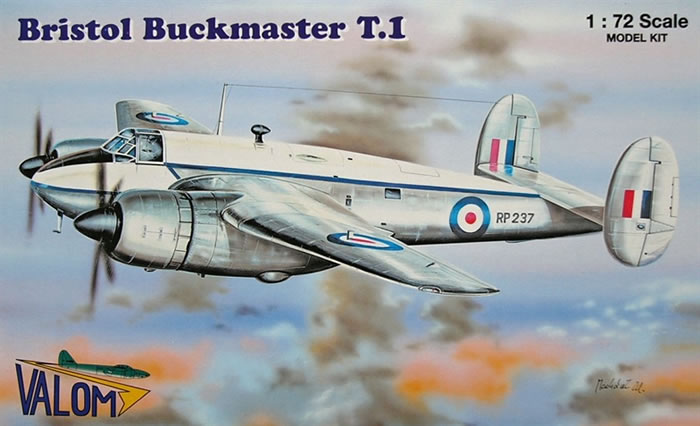
Valom, 1/72 scale
S u m m a r y : |
Catalogue Number: |
Valom Kit No. 72065 - Bristol Buckmaster T.1 |
Scale: |
1/72 |
Contents & Media |
75 x grey styrene airframe parts, 3 x clear styrene parts, 2 x resin engines, 1 x Photo Etch (PE) fret of small details with printed clear film, and decals for two aircraft. |
Price: |
Available on-line from Hannants for £29.99, Modelimex for €26.25, and NKR Models for Au$40.00 (Click here for currency conversion) |
Review Type: |
First Look |
Advantages: |
Good quality multi-media kit with delicate surface detail and quite adequate interior detail. Excellent paint colour cross- referencing in the instructions. |
Disadvantages: |
I suspect the wing is optimised for Valom’s Brigand kit, and as such lacks the Buckmaster’s leading edge intakes outboard of the engines. It may also have oversize ailerons for the Buckmaster (although I cannot advise by how much if this is the case). The side window and football DF-loop shown in the box-art is absent from the kit. Also blister fairings for the aileron actuators need to be added. |
Conclusion: |
A very good kit of an overlooked subject. Some (like me) may not be convinced that the admittedly very fine rivets benefit the kit. But this is certainly not a big enough issue to spoil things. There are a few oversights, the aileron actuator blisters being one, plus I suspect that the wing is optimised for the Brigand. Consequently it lacks the outboard leading edge intakes of the Buckmaster & Buckingham, and instead has circular ones further out. These niggles aside, it is a welcome addition to Valom’s trio of post-war Bristol twin kits. |
Reviewed by Mark Davies

Valom's 1/48 scale An-2 Colt is available online from Squadron.com
The Buckmaster’s story is really a family history shared with its siblings the Buckingham and Brigand.
The Type 163 Buckingham was Bristol’s response to specification B2/41, which was one of a line of specifications seeking a replacement for the Bristol Blenheim. Prior to this Bristol had been working on their Type 159, a bomber development of the Beaufighter – which of course was a fighter development of their Beaufort torpedo bomber. This progressed to the Type 161, and then continuing specification changes with a multi-role flavour led to the Type 162 that was to be called the Beaumont. The Beaumont never progressed beyond being a design concept, as it had become too heavy for the power of the two Hercules engines specified. Therefore development moved onto the Type 163 powered by Centaurus engines and was called Buckingham. This design was proceeded with and first flew in February 1943.
It turned out that the Mosquito could do most things the Buckingham was required for, and in addition was faster with two fewer crewmembers. Meanwhile the Douglas Boston was proving adequate in the light bomber role previously undertaken by the Blenheim. Possibly the one advantage the Buckingham had was long range, and this made it appear to be a suitable type for the war against Japan, but this need was overtaken by events as WW2 ended.
Buckingham B.1 orders were reduced by around 75% at the war’s end, and of 119 on order 65 were completed as Buckingham C.1 high-speed long-range transports. This was surely a fast but very inefficient use of 5,000 HP to transport just four passengers! The remaining B.1’s were also to be converted to C.1’s, but it seems most were scrapped.
A crew-trainer derivative was produced and known as the Buckmaster, of which 110 were assembled. These mainly saw service as Operational Conversion Units training Brigand pilots, although a few were used in Aden on communications duties. Two were used in experimental work; one testing the Burney recoilless gun and the other the combustion heaters for the Bristol Brabazon’s de-icing system.
Ironically the most significant Buckingham derivative was to take a leaf out of the Beaufort/Beaufighter story, by using the Buckingham bomber’s wings, engine and tail with a new slimmer fuselage to produce a torpedo and strike fighter called the Brigand. These saw service in the 1950’s whilst Britain quashed various colonial insurgencies.
Valom have established a good reputation for filling sought-after gaps in the 1/72 pantheon of injected kits with some very interesting releases. Their Buckingham-Buckmaster-Brigand family of kits falls firmly into this category. I’m aware of this trio being kitted previously in resin by Magna Models. Magna’s Buckmaster was okay according to a build review in Scale Aircraft Modelling International, April 1998, although it lacked the detail finesse expected of resin kit, and the white metal parts were rough. No doubt there have also been some vac-forms Buckmaster kits I’m unaware of, as there were several vac-form Brigand kits. Regardless of what’s gone before, a modern injected Buckmaster kit is very welcome.
The kit comes in Valom’s standard and adequately sturdy top-opening box with artwork that leaves no doubt about the Buckmaster’s slightly portly and pugnacious lines. The contents are sealed in a cellophane bag, with the clear parts, resin engines, PE and decals further sensibly protected in their own little bags.
The instructions are again to Valom’s usual adequate standard, printed on glossy paper and folded to form a booklet. They provide an aircraft history in both Czech and English. A parts map soon reveals with a lot of bold X’s over parts destined to top up the spares box (in particular rockets and rails from the Brigand option). The parts maps shows part numbers 10-13 as crossed out, these items being the engine nacelles. Later when the instructions cover nacelle assembly they refer to parts 15-18, yet there are only four nacelle halves provided with the kit. These are in the location the parts map indicates for parts 10-13, so clearly a mistake has occurred here.
Aside from the parts numbering confusion the assembly diagrams are clear enough to follow with just occasional instructions in Czech and English as needed. The painting and decaling guide is in colour, and a stand-out feature of Valom kits is their cross-referencing of colours to FS 595B, and the paint ranges of Humbrol, Agama, Model Master and Gunze Sangyo.
The kit parts are all clean and crisply moulded on three sprues with small sprue gates. The parts have very delicate recessed panel lines, and include extremely finely done rivets that are not too obtrusive, and are as good as is probably possible in this scale. Personally my instincts say it would be a better kit without them. But they’re in no way extreme enough for what could be a personal prejudice on my part to condemn the kit. If you don’t like them a light sand or extra primer coat should eliminate them. I suspect most will choose to keep them. I think that the problem will prove to be loss of the delicate surface detail when seams are filled and sanded, as such riveting finesse will be challenging to reinstate.
The kit follows a conventional parts breakdown for a 1940’s twin-engined tail dragger, and looks as if it will build in a straightforward manner. I think that the parts fit should be reasonable, although there is no way to be sure without building. Not everyone will like the butt-fit of the wings to the protruding wing-roots. Care will be need to ensure the wing sections are matched before the wing halves are cemented together, and gentle sanding both faces against a perfectly flat surface may prove beneficial in ensuring a flush join and correct alignment.
The parts map does guide you to select the correct engine cowls as two kinds are supplied. Make sure you do identify parts early on as there is in fact very little difference between the two styles provided. The cowls on the wing sprue (presumably the Brigand’s) are moulded slightly shorter in chord than the cowls provided on the fuselage sprues of both the Buckingham and Buckmaster kits. (The Buckingham and Buckmaster both had either Centaurus VII or XI engines, whereas production Brigands had Centaurus XVII or 57’s.)
The modeller is directed to scribe two lines in the flaps either side of the cowling (the distance for these lines is given in mm). I can’t say if these are an oversight or not, but the same instructions was included with Valom’s Buckingham kit. Anyway it’s easily addressed.
As with all Valom kits that I’ve seen there is a PE fret to cater for seat belts and other small details. A PE instrument panel with photo film is provided, and I should think that this will look good installed. Overall the detail parts provide for a nicely furnished cockpit.

The canopy is acceptably clear, and many will be happy to have the wingtip lights supplied in clear to save the effort of making their own or resorting to painted lights.
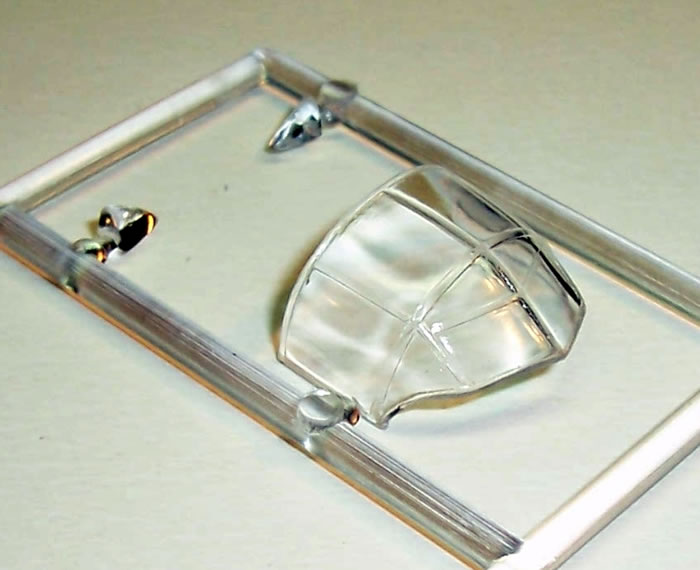
The main wheel wells have some detail that will meet the needs and expectations of most modellers. The instructions advise “move max forward” when fixing the undercarriage mounting plates, so I’d suggest this area be given some checking and test fitting to ensure that the main legs do locate in the right position within the nacelles.
Two beautiful resin Centaurus engines are provided. These have high levels of detail on both rows of cylinders and the cylinder heads. Of course most of this will go unseen behind the Buckmaster’s close-fitting cowls.

The props are moulded as four separate blades and a spinner each, and the instructions direct you to drill out the holes in the spinners to mount the blades. This reflects the limits of Valom’s tooling, and where to drill is indicated by a small pit in the spinner, so it’s an easy task to accomplish.
The decals appear to good opacity and are well registered.
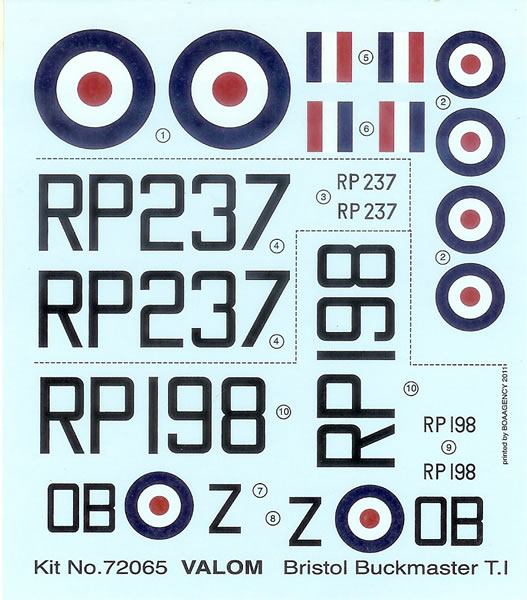
They offer an all aluminium machine with yellow trainer bands from No.45 Sqn, or an aircraft from an unidentified unit with white fuselage decking over aluminium separated by a smart blue cheat line (my guess is that this might be one of the machines that served in a liaison role in Aden).
Possible Accuracy Issues
Valom’s Brigand was the first of the three kits released. Although I have only seen the Brigand briefly when first released, I have reviewed the Buckingham a few months back; and it had the same wing as the Buckmaster. So I have assumed that the wing sprue is common to all three kits in the family. The Brigand’s wings differed from those of its siblings in having an additional 6 inches span due to a wider centre section. A 2-mm difference in 1/72 scale is for most not worth losing sleep over. However, the Brigand also had larger ailerons than its brethren, plus dive-brakes outboard of the engines and wooden wing-tips so serve as dielectric fairings (Source: Bristol Aircraft Since 1910, Putnam, 1964). Unfortunately I have been unable to find information regarding the extent of the difference in aileron size.
Information on the Brigand is far more available than on the Buckingham and Buckmaster, and I cannot advise by how much the ailerons differed. Photos do indicate that a streamlined blister over the aileron actuator is missing on each aileron (Brigands appear to have two per aileron).
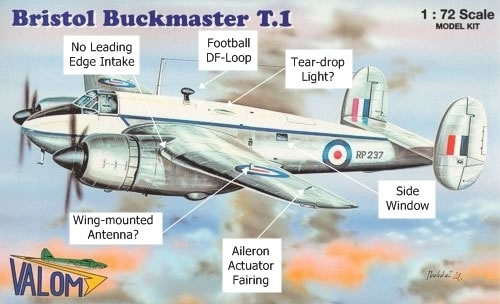
Further checking of photos showed that the kit lacks thin rectangular air intakes in the wing leading edge outboard of the engines. I have been unable to find enough Buckmaster images to say they all had them, but in all the head-on views I’ve seen they are present. I think these are worth scratch-building. Interestingly, Valom's own box-art of their other Buckmaster, without the “T.1” designation, kit #72031, is drawn with the intakes, whereas the review kit’s artwork does not show them. I’ve seen images of Brigands both with and without these intakes, but by far the majority is without, which again makes me think the kit has a Brigand wing.
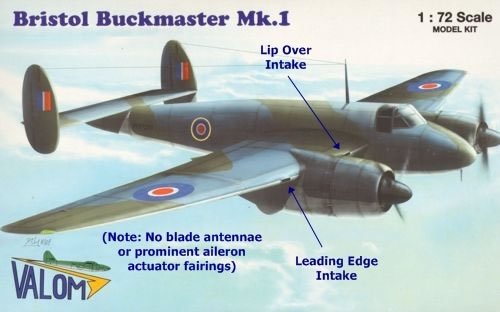
Further on the subject of leading edge intakes: Those inboard of the engines are included in the kit, but their openings conform exactly to the curve of the leading edge, whereas photos indicate that the upper opening had a slightly raised and protruding profile or lip. Also the small circular intakes the kit does provide outboard of the engines near the wing-reinforcing band are associated with Brigands, and will need to be filled in on Buckmaster and Buckingham kits.
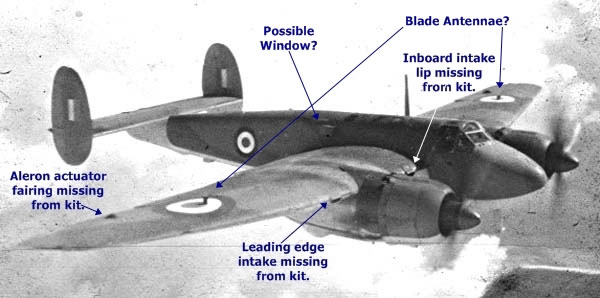
I mention these points as one style wing cannot in strictest accuracy serve all three model types. There may be those who wish to ensure they have the correct wing style for their model, in which case some reference checking will be needed.
I also noted from the Buckmaster’s box-art that it is illustrated with a small rectangular window in the fuselage aft the wing’s trailing edge, and the window’s appearance is repeated with the painting and decaling guide (but only for the white over aluminium scheme). I have not seen this window in the few photos of Buckmasters that I could find. This window is absent from the kit and so may need to be cut in and glazed for this markings option. Presumably Valom’s research indicated that this window is present on the aircraft concerned. If so they should really have included the glazing and a window opening, plus made some mention in the instructions to blank it off and paint over it for the other decal option included in the kit. Also absent from the kit but illustrated in the box-art is a football DF-loop, a tear-drop clear fitting on the upper fuselage just aft of the wing, and what looks to be some kind of blade antennae on the wings. I have seen the wing blade antennae in other Buckmaster images, but not the football or teardrop.
I would encourage Buckmaster builders to do their own research, and would welcome any information on this or any other points concerning the Buckingham-Buckmaster-Brigand family (Please e-mail me).
Overall, this appears to be a good rendition of an interesting type. Personally I’d prefer the rivets were left out in this scale for most if not all subjects, although here they seem almost okay. The parts numbering error in the instructions is a minor matter. Yet such errors are not uncommon amongst limited run manufacturers, and after many reviews I’m inclined to think that several of the Czech companies rush this phase of kit production.
Detail levels are sufficient to mean that most will probably be happy building straight from the box without additions or changes. Construction looks straightforward, but such is the nature of this kit type that care, test fitting and fine adjustment will probably be needed.
I feel fairly certain that the wings are optimised for the Brigand, and at the very least this means that the Buckmaster’s leading edge intakes outboard of the engines are probably absent, and therefore may need to be added by the modeller. Those inboard are not quite right in shape. A Brigand wing could also mean that the ailerons are oversize for a Buckmaster, but unfortunately I have no information on the extent or direction (span v chord).
Similarly, modellers selecting the box-art decal option may wish to seek photos of the aircraft portrayed to confirm the presence of side windows, football DF-loop, teardrop fairing n the upper fuselage and antennae on the wings. I’m guessing that Valom did this research, because why else would their box-art include these items? If they did, then I think that they should have included them in the kit, or at least made mention of them in the instructions.
I’m no expert, but I suspect that Valom could have done a bit more to address some of the points I have raised after only a brief perusal of references. But the real message here is to consider looking into these potential issues and satisfy yourself regarding the suspicions I have raised.
This is a very nicely done limited-run kit despite my questioning of wing issues, aileron actuator fairings, rivet detail, side windows, air intakes and DF-loops etc. I think most modellers will be impressed upon sighting the contents, and some attractive models are sure to result. For me the Buckmaster is the best looking of the Bristol trio, and a good quality injected kit of one was probably quite unexpected even just a few years ago. There will be those who are thankful for Valom for filling this gap, as they have done with many other subjects.
Despite my concerns, still highly recommended.
Thanks to Valom for this review
sample.
Review Text and Images Copyright © 2011 by Mark Davies
Page Created 14 July, 2010
Last updated
14 July, 2011
Back to HyperScale Main Page
Back to Reviews Page

|
